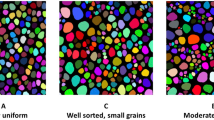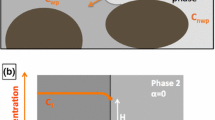Abstract
We present numerical simulations of drainage induced by air injection in a vertical water-saturated Hele-Shaw cell filled with glass microbeads. We use the macroscale Subsurface Transport Over Multiple Phases (STOMP) simulator developed by the Pacific Northwest National Laboratory’s Hydrology Group. To trigger fingering, we use random permeability fields consistent to capillary entry pressure fields. We compare the numerical results to our own experimental results shown in a previous study. We analyze the effects of the microheterogeneity degree as well as the macroscopic parameters on the gas saturation results. The main objective of the work is to investigate how microscopic effects could be accounted for by macroscopic variables during drainage.










Similar content being viewed by others
Reference
Islam, A., Chevalier, S., Ben Salem, I., Bernabe, Y., Juanes, R., & Sassi, M. (2014). Characterization of the crossover from capillary invasion to viscous fingering to fracturing during drainage in a vertical 2D porous medium. International Journal of Multiphase Flow., 58, 279–291.
Saffman, P. T. & Taylor, G. I. (1958). The penetration of a fluid into a porous medium or Hele-Shaw cell containing a more viscous liquid. Proc. Royal Society London, 245, 312–329.
Aker, E., Maloy, K. J., Hansen, A., & Batrouni, G. G. (1998). A two-dimensional network simulator for two-phase flow in porous media. Transport in Porous Media., 32, 163–186.
Lovoll, G., Meheust, Y., Maloy, K. J., Aker, E., & Schmittbuhl, J. (2005). Competition of gravity, capillary and viscous forces during drainage in a two-dimensional porous medium, a pore study. Energy, 30, 861–872.
Ferer, M., Ji, C., Bromhal, G. S., Cook, J., Ahmadi, G., & Smith, D. H. (2004). Crossover from capillatry fingering to viscous fingering for immiscible unstable flow: Experiment and modeling. Physical Review E., 70(016303), 1–7.
Holtzman, R., & Juanes, R. (2010). Crossover from fingering to fracturing in deformable disordered media. American Physical Society Physical Review E, 82(4), 046305.
Hilpert, M., & Miller, C. T. (2001). Pore-morphology-based simulation of drainage in totally wetting porous media. Advances in Water Resources., 24, 243–255.
Lehmann, P., Wyss, P., Flisch, A., Lehmann, E., Vontobel, P., Krafczyk, M., Kaestner, A., Beckmann, F., Gygi, A., & Fluhler, H. (2006). Tomographical imaging and mathematical description of porous medianused for the prediction of fluid distribution. Vadose Zone Journal., 5, 80–97.
Cense, A. & Berg, S. (2009). The viscous-capillary paradox in 2-phase flow in porous media. Paper SCA2009-13 presented at 23rd Annual Technical Symposium of the Society of Core Analysts, Noordwijk, The Netherlands.
Garcia JE & Karsten P. (2003). Flow instabilities during injection of CO2 into saline aquifers, in TOUGH Symposium, Berkeley, California.
Saadatpoor, E., Bryant, S. L., & Sepehrnoori, K. (2010). New trapping mechanism in carbon sequestration. Transport in Porous Media., 82, 3–17.
Ataie-Ashtiani, B., Hassanizadeh, S. M., & Celia, M. A. (2002). Effects of heterogeneities on capillary pressure-saturation-relative permeability relationships. Journal of Contaminant Hydrology., 56, 175–192.
Das, D. D., Mirzaei, M., & Widdows, N. (2006). Non-uniqueness in capillary pressure-saturationrelative permeability relationships for two-phase flow in porous media: Interplay between intensity and distribution of random micro-heterogeneities. Chemical Engineering Science., 61, 6786–6803.
White, M. & Oostrom, M. x(2000) STOMP Subsurface Transport Over Multiple Phases: theory guide, PNNL-12030. Pacific Northwest National Laboratory (stomp. pnnl.gov), Richland, Washington.
Hilfer, R., & Helmig, R. (2004). Dimensional analysis and upscaling of two-phase flow in porous media with piecewise constant heterogeneities. Advances in Water Resources., 27, 1033–1040.
White, M., Watson, D., Bacon, D., White, S., McGrail, B., & Zhang, Z. (2012) STOMP, Subsurface Transport Over Multiphases, STOMP-CO2 and -CO2e Guide, PNNL 21268, U.S. Department of Energy (stomp. pnnl.gov), Richland, Washington.
Lovoll, G., Jankov, M., Maloy, K., Toussaint, R., Schmittbuhl, J., Schafer, G., & Meheust, Y. (2011). Influence of viscous fingering on dynamic saturation-pressure curves in porous media. Transport in Porous Media., 86, 305–324.
Laroussi, C., & De Backer, L. (1979). Relations between geometrical properties of glass beads media and hysteresis loops. Soil Science Society American Journal., 43, 646–650.
Mualem, Y. (1976). A new model for predicting the hydraulic conductivity of unsaturated porous media. Water Resources Research., 12(3), 513–522.
Springer, D. S., Loaiciga, H. A., Cullen, S. J., & Everett, L. G. (1998). Air permeability of porous materials under controlled laboratory conditions. Ground Water, 36(4), 558–565.
Cropper, S., Perfect, E., Van den Berg, E., & Mayes, M. (2011). Comparison of average and point capillary pressure-saturation functions determined by steady-state centrifugation. Soil Physics., 75, 17–25.
Suekane, T. & Okada, K. (). Gas injection in a water saturated porous medium: effect of capillary, buoyancy, and viscosity ratio, in International Conference on Greenhouse Gas Control Technologies-11, Kyoto.
Rasband, W. S. [Online], ImageJ, U. S. National Institutes of Health, Bethesda, Maryland, USA. Available: https://imagej.nih.gov/ij/. Accessed 01 2015.
"Tecplot", Tecplot, Inc. Available: http://www.tecplot.com/. Accessed May 2015.
Hassanizadeh, S. M., Celia, M. A., & Dahle, H. K. (2002). Dynamic effect in the capillary pressure-saturation relationship and its impacts on unsaturated flow. Vadose Zone Journal., 1, 38–57.
Manthey, S., Hassanizadeh, S. M., Helmig, R., & Hilfer, R. (2008). Dimensional analysis of twophase flow including a rate-dependent capillary pressure-saturation relationship. Advances in Water Resources, 31, 1137–1150.
Author information
Authors and Affiliations
Corresponding author
Rights and permissions
About this article
Cite this article
Islam, A., Chevalier, S., Salem, I.B. et al. Numerical Simulation of Gas Injection in Vertical Water Saturated Porous Media. Environ Model Assess 23, 459–469 (2018). https://doi.org/10.1007/s10666-017-9587-x
Received:
Accepted:
Published:
Issue Date:
DOI: https://doi.org/10.1007/s10666-017-9587-x




